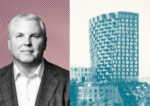San Francisco’s office vacancy rate continues to grow, but the city’s commercial agents and analysts say the data and some prominent leases point to neighborhood-by-neighborhood differences in desirability that impacts where tenants and lease dollars eventually end up.
“Most tenants want to be where the activity is, and if that activity has shifted toward a particular submarket, then that’s where they consider the new hot spot,” said Dina Gouveia, senior manager of the West Region Market for Avison Young.
Hot spots
Mission Bay appears on all the experts’ “hot lists,” mainly because it has been so attractive to big-name AI tenants, which in turn brings more tech tenants that want to be located near them.
“Mission Bay has done a great job of revitalizing itself,” said JLL analyst Chris Pham. “OpenAI’s relocation there has generated a lot of excitement and caused some companies such as Y Combinator to open offices there. This, combined with Visa’s new HQ at Mission Rock, is generating a lot of interest among companies in that area.”
The large block spaces taken by tech firms in Mission Bay run contrary to the trends in the city overall: smaller tenants in traditional office FIRE industries looking for partial and single floors. That activity is “clustering” in the North and South Financial Districts, and is extending north into Jackson Square and the North Waterfront, according to Derek Daniels at Colliers.
“Favorable perceptions of safety, less visible social issues, abundant amenities and high-quality availabilities that can accommodate smaller tenants may be driving that,” Daniels said.
Mission Bay may be far from the Financial District, but it shares some commonalities with those northern downtown neighborhoods, he added.
“Drive through that submarket and you will see clean streets, retail and an abundance of housing,” he said.
Colliers data shows office availability — which includes direct leases and subleases — in the city overall at 35.4 percent in the third quarter. But Jackson Square and Mission Bay are much lower at 22.3 percent and 24.9 percent respectively, the two lowest vacancy submarkets in the city.
The Colliers data does not cover areas well outside downtown such as the Presidio, which “has been a high-performing market given the uniqueness of the creative workspace and serene park setting with the proximity to all that San Francisco has to offer,” according to Elizabeth Hart, Newmark’s president of leasing for North America.
There may be more neighborhoods popping up on the hot list in the near future, the experts said, as some AI startups grow out of their first homes and need to take more space.
“We are seeing an influx of maturing AI startups from Hayes Valley and the Mission expanding to anywhere from Showplace Square to the North Financial District as they need more space to accommodate their growing headcount,” Pham said.
Avison Young’s Office Busyness Index, which measures activity across various office buildings using cell phone data, shows that “many of San Francisco’s fringe submarkets have experienced a significant improvement in office busyness year-over-year,” according to Louis Thibault, a senior market intelligence analyst at the firm.
For example, Potrero Hill saw a 27.6 percent increase in “busyness” year over year, largely due to an influx of AI companies, he said, while the North Financial District continues to be the strongest performing submarket post-COVID and has remained relatively stable year-over-year.
Cold spots
The South Financial district, on the other hand, has seen a 6.3 percent “busyness” dip and the experts said overall submarkets south of Market Street continue to be the most impacted by the loss of big block tech tenants, coupled with concerns about safety, less accessibility to transit and a perceived lack of amenities. Plus, buildings in SoMa are newer so their owners have a higher cost basis, making it harder for landlords to offer incentives, Thibault said.
Submarkets around Civic Center have been particularly hard hit, with Colliers data showing 38.5 percent vacancy in Mid-Market/Civic Center, 46.9 percent vacancy in SoMa East and an eye-popping 62.4 percent vacancy in Yerba Buena.
Yerba Buena has just 5 million square feet of office space, and the delivery of Brookfield’s 600,000-square-foot 5M in mid-2022 added a huge block of available square footage to that small submarket, Daniels said.
But it’s not just one poorly timed mid-pandemic project impacting vacancy numbers, he added. There are 16 buildings with more than 50,000 square feet of available space, for a total of more than 3 million square feet in that large-block segment of the market in Yerba Buena alone.
The lack of retail contributes to Yerba Buena’s current low standing among office tenants, Daniels said. Thiebult said he’s keeping his eye on Union Square for similar reasons, given that it remains a premier spot for boutiques and high-end brands, but has also faced its share of high-profile, large-block vacancies, including at the troubled nearby former mall named San Francisco Centre.
“Union Square is facing a pivotal moment in time,” he said.
Also facing a pivotal moment is Mid-Market, which was already dealing with large swaths of vacancy even before Elon Musk decided to shut down X’s headquarters there this summer. The lack of foot traffic after the closure is a significant barrier to addressing safety concerns that were already top of mind in the neighborhood, Avison Young’s Gouveia said. She added that it would take public and private partnerships to improve safety and create more activity there.
Read more
OpenAI subleases 350K sf building in San Francisco’s Mission Bay

Capgemini to relocate SF offices to Mission Rock from SoMa

Elon Musk’s X to close former HQ office in SF’s Mid-Market
Even so, she said it could only take “a few key tenants that move-in to pivot the market with activity.”
Hart at Newmark agreed that “no single company makes a neighborhood in an urban setting.”
“For every departure in San Francisco, there is a new company beginning,” she said.
Copyright for syndicated content belongs to the linked Source link








